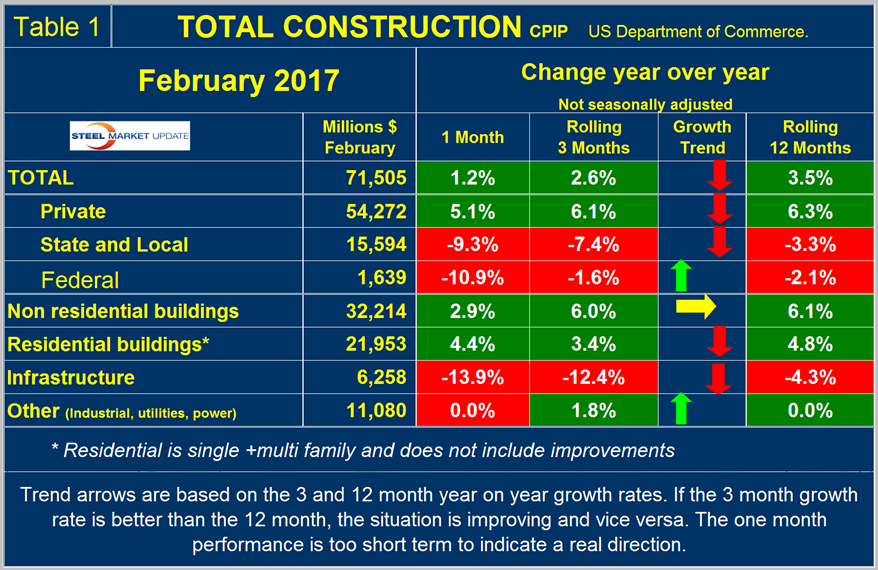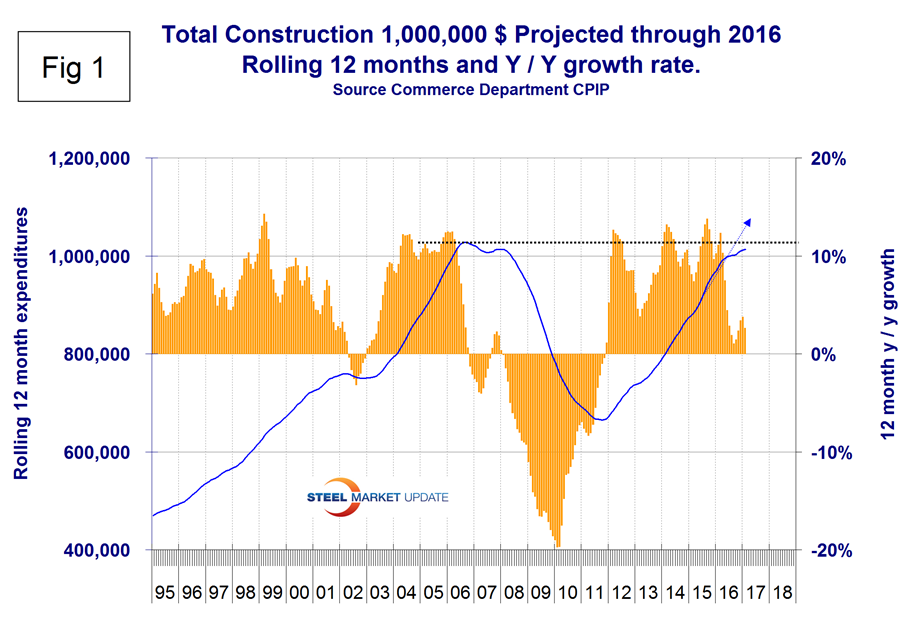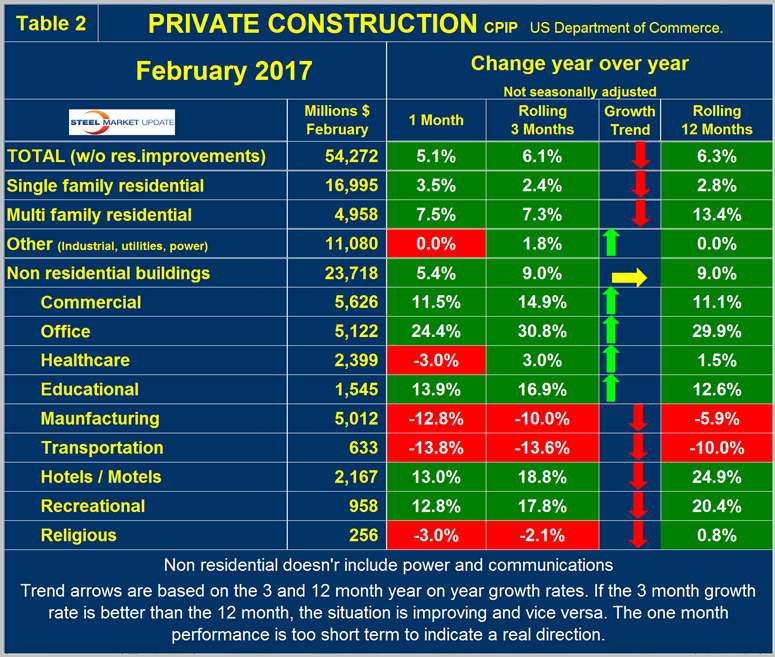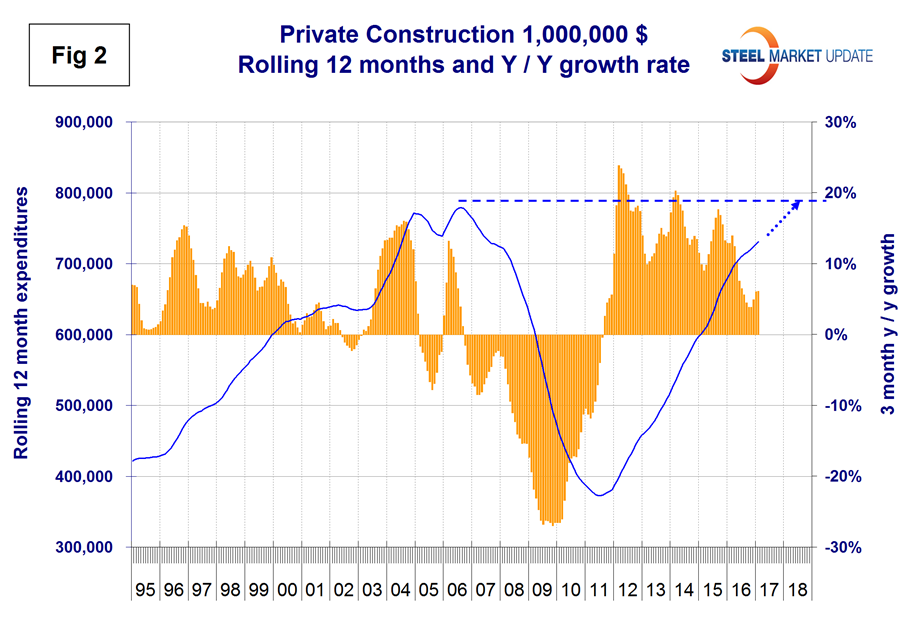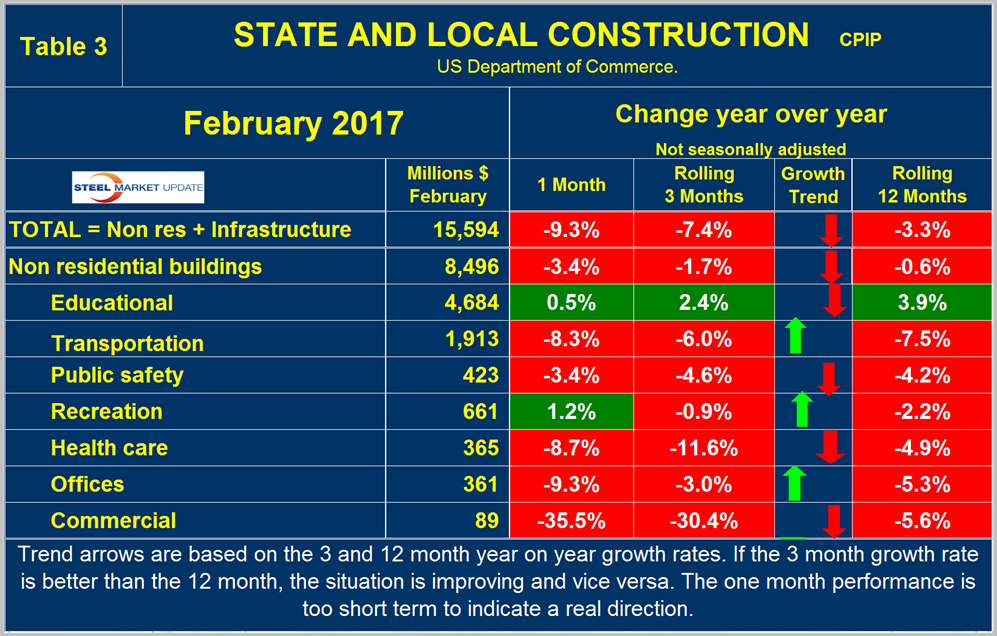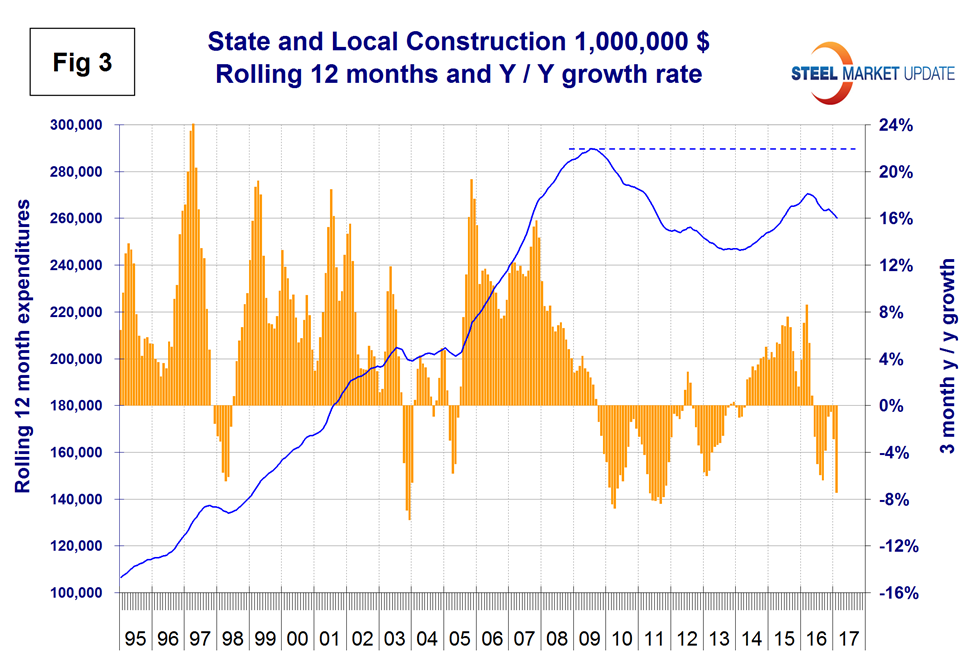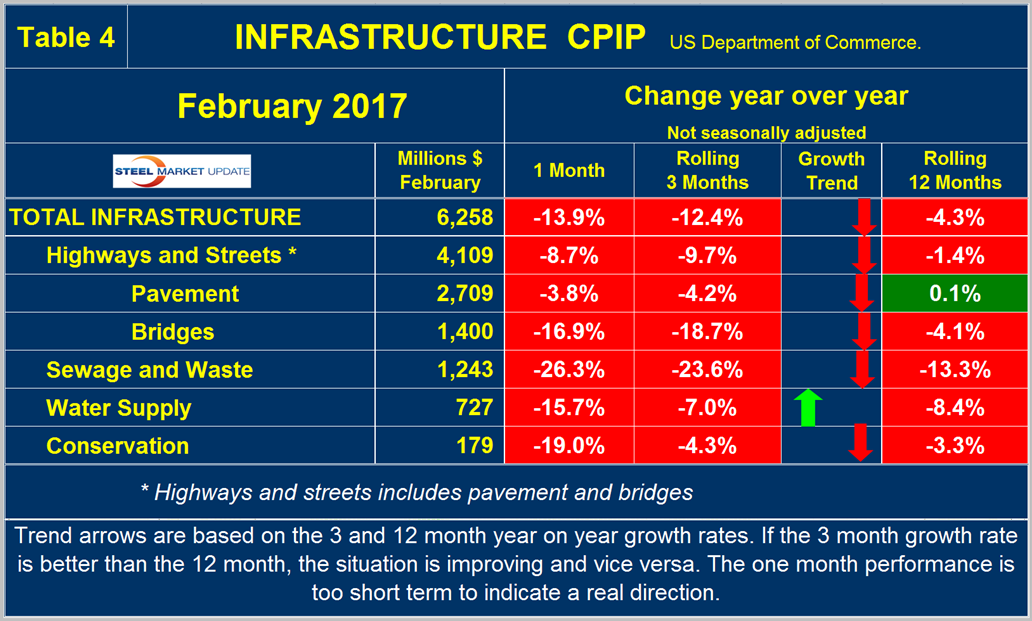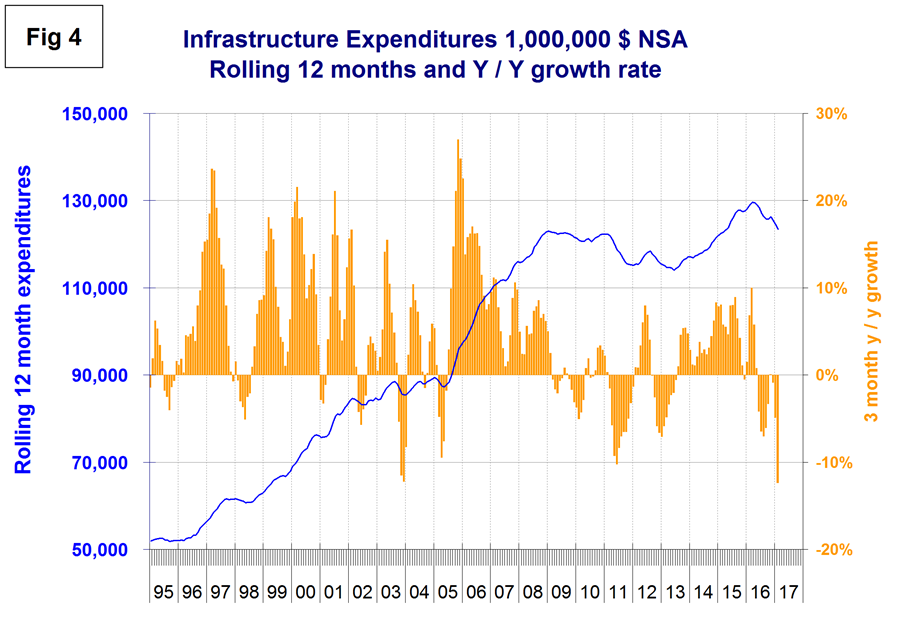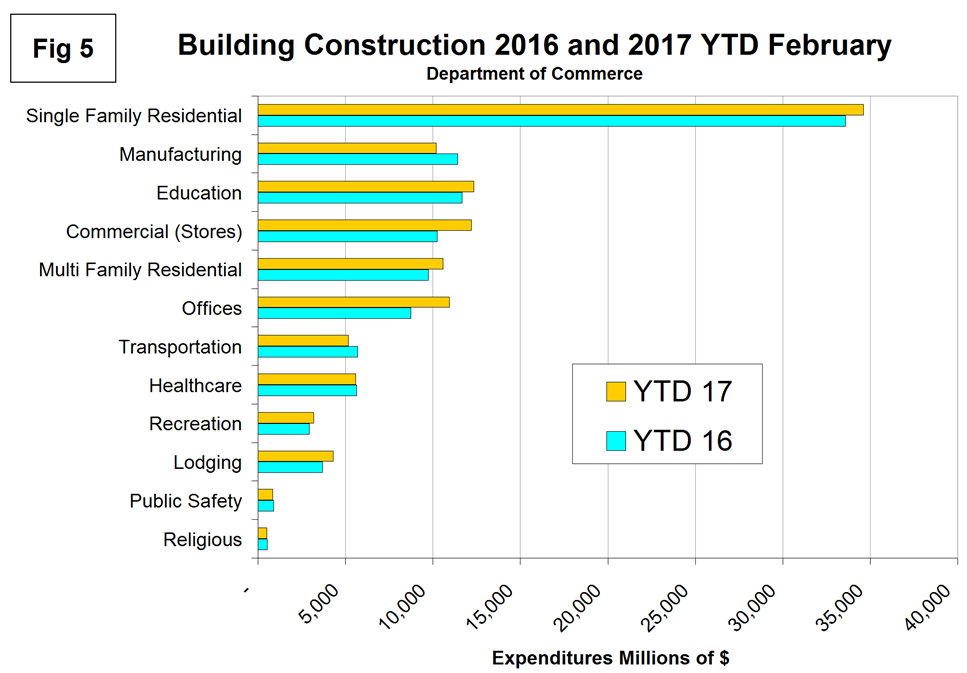Steel Markets

Construction Expenditures through February 2017
Written by Peter Wright
April 7, 2017
February data for construction put in place (CPIP) was released by the Department of Commerce on Monday March 3rd 2017. Once again this was not such a great report. Total construction is still growing though more slowly. Private construction has picked up the pace in the last three months but state and local construction is contracting faster. Any contractions that we report in this analysis are not seasonal as we are considering year/year comparisons.
![]() At SMU we analyze the CPIP data with the intent of providing a clear description of activity that we believe accounts for over 30 percent of total steel consumption. Please see the end of this report for more detail on how we perform this analysis and structure of the data but in particular note that we are presenting NONE seasonally adjusted numbers. Much of what you will see in the press may differ from our presentation because others are basing their comments on adjusted values. Our rational is that construction is highly seasonal and our businesses function in a seasonal world. Also we don’t understand how the adjustments are made neither do we trust them.
At SMU we analyze the CPIP data with the intent of providing a clear description of activity that we believe accounts for over 30 percent of total steel consumption. Please see the end of this report for more detail on how we perform this analysis and structure of the data but in particular note that we are presenting NONE seasonally adjusted numbers. Much of what you will see in the press may differ from our presentation because others are basing their comments on adjusted values. Our rational is that construction is highly seasonal and our businesses function in a seasonal world. Also we don’t understand how the adjustments are made neither do we trust them.
Total Construction
Total construction grew by 2.6 percent in three months through February year over year. This followed a 3.8 percent improvement in January. On a rolling 12 months basis construction expanded y/y by 3.5 percent which was the 59th consecutive month of positive growth. However since the 3 month growth rate is lower than the 12 month we conclude that the rate of growth is slowing and momentum is negative. All growth measures included below are on a year over year basis which is our way of eliminating seasonality.
February total construction expenditures were $71.5 billion which breaks down to $54.3 B of private work, $15.6 B of state and locally (S&L) funded work and $1.6 B of federally funded (Table 1).
The red and green arrows in all four tables in this report show momentum. Early last year we thought that total construction would reach the pre-recession level by the end of 2016. This projection is no longer true and a forecast of total recovery is no longer possible as shown by the blue line in Figure 1.
In Figures 1 through 4 in this analysis the blue line shows the rolling 12 month expenditures which smooths out seasonal variation and the brown bars show the y/y 3MMA growth rate. We consider four sectors within total construction. These are non-residential, residential, infrastructure and other. The latter is a catch all and includes industrial, utilities and power. Of these, non residential buildings had flat momentum and other had positive momentum in 3 months through February. Infrastructure and residential buildings had negative momentum. The pre-recession peak of total construction on a rolling 12 month basis was $1.028 trillion in 12 months through August 2006. The low point was $665.1 B in 12 months through February 2011. The 12 month total through the latest data of February 2016 was $1.013 trillion. August through February on a rolling 12 month basis were the first months to exceed the $ trillion level since May 2008.
Private Construction
Table 2 shows the breakdown of private expenditures into residential and non-residential and subsectors of both.
The growth rate of private construction was 6.1 percent in the three months through February, down slightly from January as shown by the brown bars in Figure 2.
Excluding property improvements our report shows that single family residential grew by 2.4 percent and multi-family residential still has a healthy 7.3 percent growth rate, both have negative momentum. The growth rates of both single family and multi family construction expenditures reported here are similar to the growth of starts reported by the Census Bureau. (In the starts data the whole project is entered to the data base when ground is broken). Single family starts grew at 0.1 percent in 3 months through February and multi family starts grew by 7.6 percent. Within private non-residential, commercial, office, healthcare and educational had positive momentum. All other sectors are slowing. The first quarter Federal Reserve Senior Loan Officer Survey indicated that there is currently a net decrease in demand for construction and land development loans and those terms are tightening. The Fed survey reviews changes in the terms of, and demand for, bank loans to businesses on a quarterly basis based on the responses from 73 domestic banks and 24 U.S. branches and agencies of foreign banks.
State and Local Construction
S&L work contracted by 7.4 percent in the rolling three months through February y/y with negative momentum (Table 3).
May last year was the last month in which S&L expenditures had positive y/y growth. Figure 3 shows y/y growth as the brown bars and the rolling 12 month total of expenditures as the blue line.
Educational buildings are by far the largest sub sector of S&L non-residential at $4.7 billion. In February on a 3MMA basis y/y educational had a positive growth of 2.4 percent with negative momentum. All other sectors contracted. Comparing Figures 2 and 3 it can be seen that S&L construction did not have as severe a decline as private work during the recession and that private work bounced back faster. Private expenditures are not likely to exceed the pre-recession high in 2017 but the downturn in S&L means that a full recovery is unlikely to be achieved in this decade.
Drilling down into the private and S&L sectors as presented in Tables 2 and 3 shows which project types should be targeted for steel sales and which should be avoided. There are also regional differences to be considered for which data is not available from the Commerce Department.
Infrastructure
Expenditures had positive growth in the first five months of last year and have not had a positive month since then. In February infrastructure had the largest contraction since our data begins 22 years ago. Highway and streets including pavement and bridges contracted by 9.7 percent y/y in February. These account for about 2/3 of total infrastructure expenditures. None of the sub sets of infrastructure had positive growth in 3 months through February. Highway pavement is the main subcomponent of highways and streets and had a 4.2 percent negative growth in three months through February. Bridge work contracted by 18.7 percent (Table 4).
Infrastructure expenditures have exceeded the pre-recession high every month since May 2015 but in the last nine months have been in a downturn (Figure 4).
We confess we don’t understand this trend and have seen nothing in our research to explain it. At the end of last year we thought that the passage of the congressional bill for $305 billion to fund roads, bridges, and rail lines that was authorized in December 2015 had finally have begun to kick but evidently that is not the case. The long lead time for approvals and project design slows the application of available infrastructure funds but it seems now that there must be some other retardant that we aren’t aware of. The 2015 five-year infrastructure bill was the largest reauthorization of federal transportation programs approved by Congress in more than a decade, ending an era of stopgap bills and half-measures that left the Highway Trust Fund nearly broke and frustrated local governments and business groups.
Total Building Construction Including Residential
Figure 5 compares YTD expenditures for building construction for 2016 and 2017.
Single family residential is dominant and in the 12 months of 2016 totaled $243 billion, up from $233 billion in 2015. In the first two months of 2017 y/y all project segments except manufacturing, transportation, public safety and religious had positive growth led by offices up by 25.4 percent and commercial (mainly stores) up by 19.1 percent.
Explanation: Each month the Commerce Department issues its construction put in place (CPIP) data, usually on the first working day covering activity two months earlier. Construction put in place is based on spending work as it occurs, estimated for a given month from a sample of projects. In effect the value of a project is spread out from the project’s start to its completion. This is different from the starts data published by the Census Bureau for residential construction, by Dodge Data & Analytics and Reed Construction for non-residential and Industrial Information Resources for industrial construction. In the case of starts data the whole project is entered to the data base when ground is broken. The result is that the starts data can be very spiky which is not the case with CPIP.
The official CPIP press release gives no appreciation of trends on a historical basis and merely compares the current month with the previous one on a seasonally adjusted basis. The data is provided as both seasonally adjusted and non-adjusted. The detail is hidden in the published tables which we at SMU track and dissect to provide a long term perspective. Our intent is to provide a rout map for those subscribers who are dependent on this industry to “Follow the money.” This is a very broad and complex subject therefore to make this monthly write up more comprehensible we are keeping the information format as consistent as possible. In our opinion the absolute value of the dollar expenditures presented are of little interest. What we are after is the magnitude of growth or contraction of the various sectors. In the SMU analysis we consider only the non-seasonally adjusted data. We eliminate seasonal effects by comparing rolling three month expenditures year over year. CPIP data also includes the category of residential improvements which we have removed from our analysis in the rational that such expenditures are minor consumers of steel.
In the four tables included in this analysis we present the non-seasonally adjusted expenditures for the most recent data release. Growth rates presented are all year over year and are the rate for the single months result, the rolling 3 months and the rolling 12 months. We ignore the single month year/year result in our write ups because these numbers are preliminary and can contain too much noise. The arrows indicate momentum. If the rolling 3 month growth rate is stronger than the rolling 12 months we define this as positive momentum and vice versa. In the text, when we refer to growth rate we are describing the rolling 3 months year over year rate. In Figures 1 through 4, the blue lines represent the rolling 12 month expenditures and the brown bars represent the rolling 3 month year over year growth rates.

Peter Wright
Read more from Peter WrightLatest in Steel Markets

USW cheers Evraz NA agreement with Atlas Holdings
The United Steelworkers (USW) labor union celebrated recent news of the signed agreement between Atlas Holdings and Evraz NA in which the Connecticut-based private equity company said it plans to acquire North America’s Evraz facilities.

Steel buyer spirits tempered by soft spot market conditions
Steel sheet buyers report feeling bogged down by the ongoing stresses of stagnant demand, news fatigue, tariff negotiations or implementation timelines, and persistent macroeconomic uncertainty.

Hot-rolled coil buyers continue seeking certainty
Steel market participants contend that buyers will remain in “wait-and-see" mode until some market stability is restored.

Latin American steel advocates warn on cheap import flood
Subsidized Chinese steel imports and cheap steel products from Association of Southeast Asian Nations (ASEAN) entering Latin American (LATAM) are threatening the region's steel market.

CRU: Steel prices fall amid global demand weakness
The forceful headwinds bearing down on steel markets across the globe have created demand challenges and sent prices southward. The US, however, challenged the global trend.

